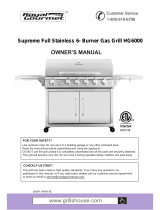i i
T ABLE OF CONTENTS
Warranty . . . . . . . . . . . . . . . . . ii
Installation . . . . . . . . . . . . . . . 1
Additional Warnings . . . . . . . . 1
L.P. Gas Cylinder, . . . . . . . . . . . 1
Transportation and
Storage of Cylinder,
Filling the Cylinder
Hose and Regulator . . . . . . . . . 3
Leak Testing . . . . . . . . . . . . . . 3
Lighting the Grill . . . . . . . . . . . 5
Rotisserie Burner . . . . . . . . . . . 7
Igniter Lighting
Tips on Using . . . . . . . . . . . . . 7
Your Rotisserie
Tips on Using . . . . . . . . . . . . . 8
Your Barbecue
Information on Natural Gas . . . 9
Cleaning and Maintenance, . . 10
Storage
Troubleshooting Guide. . . . . . 11
Parts List and. . . . . . . . . . . . . 12
Parts Diagram (Propane)
Parts List and. . . . . . . . . . . . . 14
Parts Diagram (Natural Gas)
Assembly Instructions . . . . . . 16
W ARRANTY
5 Year Limited Warranty
This Centro BBQ carries a five year limited warranty against defects in manufacturing
workmanship. This Limited Warranty is nontransferable and becomes void if used for
commercial or rental purposes. This warranty applies only when grill is used in Canada.
The bill of sale or a copy will be required together with the serial number and model
number when making any warranty claims from Trileaf Distribution. Trileaf Distribution
reserves the right to have its representatives inspect any product or part prior to hon-
ouring any warranty claim. Trileaf Distribution shall no be liable for any transportation
charges, shipping and handling charges, or labour cost. This warranty is for replace-
ment of defective parts only. The Manufacturer will not be responsible for incidental or
consequential damages or any labor cost. Inability to provide proof of purchase, or if
warranty coverage has expired, any request for parts will be subject to parts, shipping
and handling fees. This limited warranty does not cover damage due to chipping and
scratching of porcelain or painted surfaces including Cooking grates, nor does
it cover
corrosion or discolouration due to misuse, lack of maintenance, grease fires, hostile
environments, accidents, alterations, abuse or neglect, improper installation and failure
to read and/or abide by any product warnings. This limited warranty does not cover any
damage sustained during removal or storage of this BBQ. Part failure due to lack of
cleaning and maintenance, or use of improper cleaning products such as Oven Cleaner,
will not be covered under this manufacturers warranty. This limited warranty does not
cover any scratches or dents, corrosion or discolouring caused by heat, abrasive or
chemical cleaners. Parts installed from other manufactures will nullify this warranty.
5 Year Limited Warranty
3 Year Limited Warranty
1 Year Limited Warranty
For one year from the date of original retail purchase Trileaf Distributions will
replace any grill part that fails or is found to be defective to the degree of non-
performance under normal household use, during the limited warranty period.
Trileaf Distributions Ltd. is not responsible for any grill damage sustained during
moving, storage, assembling or cleaning.
Unless otherwise noted, as in above lim-
itations, all components are covered for a period of one year.
IMPORTANT: Should you have difficulty operating this product, or have a
part that has become defective within the stated warranty period, DO NOT
RETURN TO STORE. STORES DO NOT STOCK REPLACEMENT PARTS AND ARE
UNABLE TO HELP WITH TROUBLESHOOTING ADVICE. PLEASE CALL 1-877-
707-5463. Have your Proof of purchase, serial number and model number
available so that the customer support agent can be of assistance.
Purchaser: By accepting delivery of this Barbecue the purchaser, hereby accepts
the foregoing and expressly waives any other remedy and damages, direct, indi-
rect, and consequential.
The following functional parts are included under this warranty: Burners, manifold assem-
bly and carryover assembly.
The following functional parts are included under this warranty: Burners, manifold assem-
bly and carryover assembly.






















